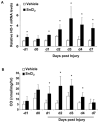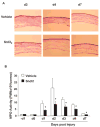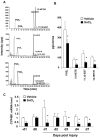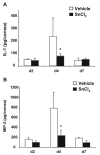Heme oxygenase-1 induction attenuates corneal inflammation and accelerates wound healing after epithelial injury
- PMID: 18441305
- PMCID: PMC2574648
- DOI: 10.1167/iovs.07-1515
Heme oxygenase-1 induction attenuates corneal inflammation and accelerates wound healing after epithelial injury
Abstract
Purpose: Heme oxygenase (HO) is considered a fundamental endogenous immunomodulatory, cytoprotective, and anti-inflammatory system. This protective function is primarily ascribed to the inducible HO-1. The authors examined the effect of HO-1 induction on corneal inflammation and wound healing in mice undergoing epithelial injury.
Methods: C57BL6 mice were treated with SnCl(2) the day before epithelial injury and once daily thereafter. The corneal epithelium was removed with the use of a corneal rust ring remover in anesthetized mice. Reepithelialization was measured by fluorescein staining. The inflammatory response was examined by histology and was quantified by the myeloperoxidase assay. Inflammatory lipid mediators were detected and quantified by LC/MS/MS-based lipidomic analysis. HO-1 expression was assessed by real-time PCR, and HO activity was determined by measuring HO-dependent carbon monoxide production.
Results: Epithelial injury caused a time-dependent transient increase in HO-1 expression and HO activity that was significantly amplified by treatment with SnCl(2), resulting in a twofold to threefold increase in mRNA levels and a similar increase in corneal HO activity. Induction of HO-1 was associated with a significant acceleration of wound healing when compared with a vehicle-treated group and with attenuation of the inflammatory response, evidenced by a significant decrease in the number of infiltrating cells and by a significant reduction in the expression and production of proinflammatory lipid mediators and cytokines.
Conclusions: Increased expression of HO-1 provides a mechanism that modulates inflammation and promotes wound closure; pharmacologic amplification of this system may constitute a novel strategy to treat corneal inflammation while accelerating wound repair after injury.
Figures





References
-
- Abraham NG, Kappas A. Heme oxygenase and the cardiovascularrenal system. Free Radic Biol Med. 2005;39(1):1–25. - PubMed
-
- Ryter SW, Alam J, Choi AM. Heme oxygenase-1/carbon monoxide: from basic science to therapeutic applications. Physiol Rev. 2006;86(2):583–650. - PubMed
-
- Liu N, Wang X, McCoubrey WK, Maines MD. Developmentally regulated expression of two transcripts for heme oxygenase-2 with a first exon unique to rat testis: control by corticosterone of the oxygenase protein expression. Gene. 2000;241(1):175–183. - PubMed
-
- Otterbein LE, Bach FH, Alam J, et al. Carbon monoxide has anti-inflammatory effects involving the mitogen-activated protein kinase pathway. Nat Med. 2000;6(4):422–428. - PubMed
Publication types
MeSH terms
Substances
Grants and funding
LinkOut - more resources
Full Text Sources
Research Materials

